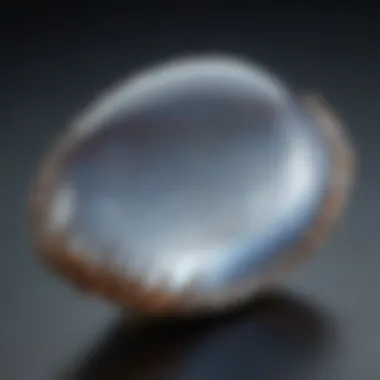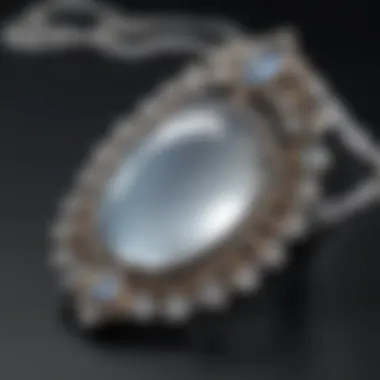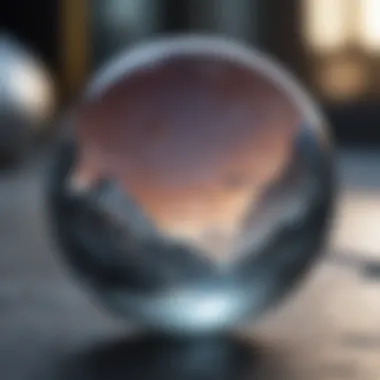Your Ultimate Guide to Buying Moonstone


Gemstone Overview
Definition and Characteristics
Moonstone is a gemstone that exhibits a unique optical phenomenon known as adularescence. This effect produces a glowing light that seems to float across the surface of the stone, reminiscent of the moon's glow. Typically translucent to transparent, moonstone is composed of feldspar, a common mineral found in the earth's crust. The range of colors varies from colorless to shades of blue, cream, gray, and even brown. The most valuable specimens display a vivid blue sheen, often referred to as blue moonstone.
Some characteristics to consider when evaluating moonstone include:
- Color: Various shades make each stone unique.
- Clarity: Visible imperfections can impact the gem’s value.
- Cut: Quality of cut often affects how well the adularescence is displayed.
- Carat Weight: Larger stones are typically more valuable.
Classification of Gemstones
Gemstones can be classified into several categories based on their composition and properties. Moonstone belongs to a specific family of gemstones known as silicate minerals. Other classifications include precious and semi-precious. While precious stones like diamonds and rubies are often more valued, semi-precious stones like moonstone have their own appeal due to unique aesthetic qualities and cultural significance.
Historical Significance
Ancient Uses and Cultural Importance
The history of moonstone is rich and diverse. Ancient civilizations, including the Romans and Greeks, believed moonstone held mystical properties. It was often associated with the lunar cycle and was thought to bring protection, fertility, and good fortune. In India, moonstone is known as a sacred gem and was used in amulets and talismans.
Today, moonstone is also popular in contemporary jewelry. Its historical roots enhance its desirability, making it a preferred choice for collectors and jewelers alike.
Myths and Legends Surrounding Gemstones
Various cultures have their own stories and beliefs about moonstone. In some traditions, it is said to contain the spirit of the moon and can help individuals connect with their intuition. Others suggest it symbolizes new beginnings and transformation. Such narratives link the gemstone not just to aesthetic beauty but also to emotional and spiritual significance.
"Moonstone's enchanting glow and rich history make it a sought-after gem for both decorative and meaningful purposes."
Understanding these aspects can enrich one’s appreciation for moonstone and inform buying decisions.
Understanding Moonstone
Understanding moonstone is an essential aspect of this guide. This gemstone has captivated many for generations because of its unique characteristics and beauty. Knowing what moonstone is and how it is created enhances appreciation and informs better purchasing decisions. For potential buyers, knowledge about moonstone can open up a world of options, allowing them to recognize quality pieces versus lesser ones. This section will lay the foundation for evaluating moonstone not only as a piece of jewelry but also as a valuable natural resource.
What is Moonstone?
Moonstone is a type of feldspar mineral, categorized under the orthoclase group. It is characterized by its distinctive visual effects, particularly the phenomenon known as adularescence. This gemstone displays an enchanting glow, resembling soft shades of moonlight, which is why it has gained its name. The colors may range from translucent to milky white, but it can also come in shades of peach, gray, and blue. Many enthusiasts are drawn to moonstone for its mystical qualities, often linked to intuition and emotional balance.
The popularity of moonstone has surged in recent years, especially among jewelry designers. It is used in various settings, often paired with gold or silver, adding an element of romance and elegance. However, understanding the uniqueness of moonstone goes beyond appearance, involving its physical and metaphysical properties.
The Geological Formation of Moonstone
Moonstone is primarily formed in igneous rocks found in volcanic regions. The mineral’s beauty stems from the way light interacts with its layers. Over thousands of years, geological changes and heat enable the feldspar crystals to grow. The formation process involves the separation of different feldspar components, orthoclase and albite. This separation creates the layers that cause the gem's reflective qualities.
Geologists believe that moonstone can be found in various locations globally, including Sri Lanka, India, and Madagascar. Each geographical region contributes different qualities to the stones mined from that area. Some may possess finer clarity, while others may have distinct coloration. Hence, knowing the origin of a moonstone can inform about its potential value and rarity.
Optical Phenomena: Adularescence
Adularescence is the key optical phenomenon that defines moonstone. It refers to the visual effect that occurs when light reflects from the internal layers of the gem. This gives the stone its hallmark glow, often resembling a moonlit sheen. The phenomenon occurs due to the layering of feldspar minerals, where light refracts and scatters between the layers and gives rise to soft, glowing colors. The intensity and quality of adularescence can vary, significantly influencing the gem's perceived value.
Several factors affect the strength of this optical effect:
- Thickness of the layers: Thicker layers often produce a stronger glow.
- Lighting conditions: Different light sources can enhance or diminish the adularescent effect.
- Surface imperfections: A flawless surface can allow light to pass through efficiently, increasing the appealing glow.


A well-executed cut that exposes this phenomenon is a hallmark of quality moonstone. Enthusiasts should look closely for adularescence when evaluating potential purchases, as it is a major determinant of worth and desirability.
"Understanding the optical effects of moonstone is vital for both appreciation and investment. It informs buyers about how to evaluate the quality of their choices."
In summary, having a solid understanding of what moonstone is, recognizing its formation process, and appreciating the optical effects can greatly enhance the experience for buyers and collectors alike.
Types of Moonstone
Understanding the various types of moonstone is crucial for any potential buyer. Each type offers distinct characteristics that not only influence aesthetic appeal but also dictate market value. Collectors, designers, and gemstone enthusiasts not only seek beauty but also the inherent properties that each type presents. These distinctions allow buyers to make informed decisions tailored to their preferences and needs.
Color Variations in Moonstone
Moonstone exhibits various color variations that range from traditional shades to more exotic hues. The most common colors include white, blue, gray, and peach.
- White Moonstone: This is the classic variant, showcasing a translucent appearance with an ethereal glow. Its subtle charm makes it a popular choice for jewelry.
- Blue Moonstone: Recognized for its striking blue sheen, this variant often elicits a sense of calm and balance. It has gained traction as a preferred choice in modern jewelry.
- Gray Moonstone: Slightly less common, gray moonstone tends to possess a more muted glow. It provides a sophisticated touch, aligning with minimalistic design aesthetics.
- Peach Moonstone: This type offers warmth and softness, ideal for those seeking a more romantic element in their designs.
Each color variation offers different experiences depending on light and angle, enhancing the allure of this gemstone. The choice of color can reflect personal identity or complement specific occasions, making knowledge of these variations essential.
Different Cuts and Shapes of Moonstone
The cut and shape of moonstone significantly affect its appearance and desirability. The craftsmanship involved in cutting moonstone must consider its unique properties to display the best of its optical phenomena.
- Cabochon Cut: This is the most prevalent choice for moonstone. The smooth, rounded shape enhances the adularescence while providing a tactile experience. It's often used in rings and pendants.
- Faceted Cuts: Although less common, faceting moonstone can add brilliance and a modern edge to the stone. However, this cut requires careful attention to avoid losing the gemstone’s mesmerizing effects.
- Shapes: Moonstone is available in various shapes, including rounds, ovals, and freeform designs. The choice of shape typically aligns with the overall design aesthetic of the jewelry piece.
Understanding these cuts not only helps in selecting the right piece but also influences maintenance and care, as different shapes may be more susceptible to damage.
A Comparison of Rainbow Moonstone and White Moonstone
Rainbow moonstone and white moonstone often confuse buyers due to their similar appearances. However, they present different qualities.
- Rainbow Moonstone: This variant captivates with its distinct play of colors, often presenting a spectrum of hues that shift with light. The iridescence can feature vibrant blues, greens, and even purples. It is generally more sought after, bringing a unique bold element to jewelry.
- White Moonstone: While also stunning, it typically does not exhibit the same array of colors found in rainbow moonstone. Rather, its presence is more understated, appealing to those who favor simplicity.
When considering a purchase, one must think about personal taste and application. Rainbow moonstone might appeal to those wanting to make a statement, while white moonstone suits more traditional preferences. Both types have their respective values in the market, influenced by factors such as clarity and color play.
"Understanding the various types of moonstone allows buyers to appreciate not just the beauty, but also the value and investment potential of their purchase."
Evaluating Moonstone Quality
Evaluating moonstone quality is fundamental for anyone looking to purchase this unique gemstone. Quality assessment not only confirms the stone’s natural beauty but also its value. Factors such as clarity, color play, and cutting techniques significantly influence the overall appeal of moonstone. By grasping these elements, buyers can make informed decisions which align their preferences with their investment goals.
Understanding Clarity and Transparency
When assessing moonstone, clarity and transparency are crucial. Clarity refers to the presence of inclusions or flaws within the stone. An excellent moonstone should be free from visible inclusions, allowing its intrinsic beauty to shine through. Transparency enhances the stone's visual impact; high-quality moonstones appear clear and luminous.
Considerations regarding clarity include:
- Types of inclusions: Lesser-known inclusions can sometimes enhance beauty, yet common ones detract from value.
- Visual inspection: A close examination under good lighting can reveal clarity.
- Origin: Different sources may produce varying quality.
The Importance of Color Play
Color play is yet another vital aspect in determining moonstone's quality. This phenomenon, often referred to as adularescence, is the soft glow or shimmer visible beneath the surface. The intensity and color of this effect vary among stones, contributing to their allure.
Aspects to consider include:


- Color variation: Different shades, such as blue or rainbow color play, can influence desirability.
- Angle of light: Observing the stone under diverse lighting can showcase its unique properties.
- Consistency: A moonstone with consistent and striking color play is typically regarded as superior.
"High-quality moonstone engages observers with its captivating color play, an enchanting trait that many collectors seek."
Assessing the Cut Quality
The cut quality of moonstone plays a vital role in its overall presentation. A well-cut stone maximizes the appearance of color play and clarity. The cutting process should retain as much of the raw stone as possible while ensuring optimal light reflection.
To assess the cut of a moonstone, consider:
- Proportions: Well-balanced dimensions lead to a more attractive object.
- Symmetry: Uniformity contributes to both beauty and durability.
- Finish: A polished surface enhances light reflection, intensifying the color play.
In summary, evaluating moonstone quality involves an analysis of its clarity, color play, and cut quality. Each of these factors intertwines, creating an intricate portrait of value and desirability. By understanding these elements, buyers are better equipped to select moonstones that not only appeal aesthetically but are also sound investments in the gemstone market.
Buying Considerations
Buying considerations are crucial when it comes to acquiring moonstone. This gemstone, cherished for its unique qualities, can vary significantly in terms of quality, price, and source. Understanding the nuances of buying moonstone provides a foundational advantage, whether you are a collector, jeweler, or someone looking for a special piece of jewelry.
First, deciding where to purchase moonstone requires careful evaluation. The reputation of the source can dramatically influence both the quality of the moonstone and the fairness of the price. Additionally, familiarity with the market helps buyers understand pricing factors, avoiding overpricing or scams.
Another consideration is how to identify a suitable retailer. In a world where online shopping is prevalent, knowing how to sift through various options can save time and money. A well-researched purchasing process also enhances satisfaction with both the product and the purchasing experience. Being informed allows buyers to take calculated risks while minimizing potential pitfalls.
Identifying Reputable Sources
Finding a reputable source for moonstone is one of the most significant steps in the buying process. It sets the groundwork for ensuring that the gemstone you're purchasing is genuine and of high quality. Look for sellers with established credibility, often characterized by positive reviews and a long-standing presence in the market. Referring to industry-specific forums and bazaars can also provide insights into reliable retailers.
When evaluating a vendor, consider the following:
- Website Transparency: Authentic sellers often have professional websites detailing their products and sourcing methods.
- Certificates of Authenticity: Ask for documentation that verifies the gemstone's quality and origin.
- Return Policies: A clear and fair return policy often indicates confidence in product quality.
Understanding Pricing Factors
The pricing of moonstone is influenced by various factors, including the stone's size, color, clarity, and cut. Certain characteristics can drive higher prices, while others might make a stone more accessible. For example, stones exhibiting vibrant colors and strong adularescence typically command higher prices. In addition, larger stones are rarer and thus more valuable.
It is also essential to compare prices across multiple sources. Here are some pointers:
- Market Research: Look at different vendors to gauge average market prices.
- Quality vs. Price: Make sure that price reflects quality. A lower price may indicate inferior quality.
- Sales and Discounts: Keep an eye out for potential sales or clearance options, but ensure quality is not compromised.
Where to Buy Moonstone Online
In today's digital age, buying moonstone online has become increasingly popular. Multiple platforms provide a variety of options, from mainstream jewelry sites to specialized gemstone stores. Some of the most credible sources for purchasing moonstone online include:
- Etsy: Offers a wide selection of artisan-crafted moonstone jewelry.
- Blue Nile: Known for their extensive collection of high-quality gemstones, including moonstone.
- Gem Rock Auctions: A specialized platform for gemstone buyers and sellers.
- eBay: With careful selection, eBay can be a resource for finding moonstone at competitive prices.
Always remember to validate feedback and ratings before making a purchase.
Avoiding Common Fraud Schemes
Unfortunately, the gemstone trade is susceptible to fraud, and buyers must be vigilant. Recognizing common schemes can protect investments. Here are some tactics to consider:
- Overly Low Prices: If a deal appears too good to be true, it likely is. High-quality moonstones do not come with rock-bottom prices.
- Imitations: Authorities on gemstones have often exposed synthetic or imitation stones being marketed as genuine moonstone. Research and knowledge are essential to differentiate between them.
- Pressure to Buy: Be cautious of sellers who push for an immediate purchase or create artificial urgency. A reputable seller will allow you time to consider your decision.
By taking these precautions, buyers can navigate the complexities of acquiring moonstone confidently.


Caring for Moonstone
Taking care of moonstone is essential for maintaining its aesthetics and prolonging its life. This gemstone can be sensitive, and neglecting proper care can lead to damage or loss of clarity. Understanding how to clean, store, and assess the durability of moonstone will enhance its beauty and ensure it remains a cherished part of any collection or jewelry.
Cleaning Moonstone Effortlessly
Cleaning moonstone doesn't have to be complicated. It's important to approach this with caution, as harsh chemicals can damage the surface. A simple cleaning solution of mild soap and lukewarm water does the job. Use a soft cloth or a non-abrasive brush to gently scrub. Avoid using ultrasonic cleaners, as these can cause stress fractures. After cleaning, make sure to rinse the stone thoroughly with clean water and dry it with a soft cloth. This method preserves the gem's adularescence, the optical phenomenon that makes moonstone so special.
Storing Moonstone Properly
Proper storage is vital for protecting moonstone from scratches and scratches. Store your moonstone jewelry separately from other gemstones to prevent abrasion. A soft cloth pouch or a jewelry box lined with velvet is recommended. Keeping moonstone away from direct sunlight is also advisable, as prolonged exposure can fade its color. Additionally, avoid stacking items that could apply pressure on the stone, which can lead to cracks or breaks.
Understanding the Durability of Moonstone
Moonstone ranks between 6 and 7 on the Mohs scale of mineral hardness. This means that, while it is relatively sturdy, it is not as durable as some other gemstones like sapphire or diamond. Care should be taken to avoid impacts with hard surfaces. Regular inspections can help to identify any signs of wear or damage. Given its sensitivity to temperature changes, it is important to avoid exposing moonstone to extreme conditions. Keeping these factors in mind will enhance not only the aesthetic appeal of moonstone but also its longevity.
Proper care of moonstone significantly contributes to its longevity and beauty, making it a worthwhile effort for any gem enthusiast.
Market Trends and Future Outlook
Understanding market trends for moonstone is crucial for any prospective buyer or investor. This section includes insights into the overall popularity of moonstone, its cultural significance, and an analysis of investment potential. With its unique optical phenomena and rich folklore, moonstone is gaining attention not only among jewelry designers but also among collectors and gemstone enthusiasts.
Moonstone in Popular Culture
Moonstone has captivated the imagination of artists, designers, and consumers alike. Its enchanting glow and ethereal quality often make it a centerpiece in various forms of art and design. In literature, moonstone appears as a symbol of hope and renewal, often associated with the moon itself.
Over the years, various celebrities have donned moonstone jewelry, increasing its visibility. Social media platforms like Instagram and Pinterest feature numerous posts showcasing moonstone pieces, driving demand further. The rise in alternative and holistic practices has also enhanced the stone's appeal, as moonstone is thought to hold emotional and healing properties. This surge in popularity indicates a shift in consumer preference towards gemstones that are not only beautiful but also carry personal significance.
Market Analysis for Moonstone Investments
Investing in moonstone can be lucrative, but it requires careful analysis. Market dynamics have shown that the value of specific types of moonstone, especially high-quality specimens, is steadily increasing. Factors influencing this trend include rarity, quality, and demand.
Recent reports indicate a growing interest in gemstones among younger investors. Many see moonstone as an attractive alternative to more traditional investments, like stocks or bonds. The gemstone market is relatively less volatile, providing a safety net for investors.
To better understand market performance, potential investors should consider these aspects:
- Quality of Moonstone: Higher quality stones typically command better prices.
- Market Digestibility: As more consumers learn about moonstone, its charm can lead to increased demand.
- Rarity and Availability: Sources for premium moonstone may not be infinite, making some varieties more sought after.
Emerging Trends in Gemstone Jewelry
The jewelry market finds itself in constant evolution, with consumers increasingly gravitating towards unique and meaningful pieces. Moonstone fits well within these emerging trends, as it provides both a distinct aesthetic and a personal story. Jewelers are now focusing on bespoke designs, often featuring moonstone as a central element.
Sustainable and ethically sourced materials are also becoming significant considerations in gemstone acquisition. Moonstone, which is often sourced from responsible miners, aligns well with these ethical buying trends. This transparency boosts consumer confidence, making moonstone an even more appealing choice.
Moreover, technological advancements allow for innovative cutting techniques that highlight moonstone's optical effects, particularly adularescence. The trend of personalized jewelry and engagement rings featuring moonstone also continues to rise, resonating with buyers who value authenticity.
"Investors and buyers alike should keep a vigilant eye on market movements and trends that can affect the value of moonstone investments."
Understanding these market trends and consumer behaviors provides key insights for potential buyers and investors in the realm of moonstone.
Culmination
The conclusion serves as a vital section of this guide, summarizing the extensive exploration of moonstone and cementing the knowledge gained throughout the article. Understanding the nuances of moonstone is not just about appreciating its beauty; it encompasses recognizing its geological origins, evaluating quality factors, and making informed purchasing decisions. In this era of information saturation, synthesizing knowledge into clear takeaways is essential for both novice and seasoned gemstone enthusiasts.
Key Takeaways
- Moonstone's Unique Characteristics: The distinct optical effect, known as adularescence, sets moonstone apart from other gemstones. This effect can significantly influence its appeal and market value.
- Quality Evaluation is Crucial: Potential buyers should assess clarity, color play, and cut quality before making a purchase. Understanding these factors aids in acquiring genuine moonstone.
- Reputable Sources Ensure Trust: Identifying reliable sellers is paramount. This can help one avoid counterfeit stones and ensure value for investment.
- Market Trends Impact Pricing: Like any collectible, market trends dictate the price of moonstone. Awareness of these trends can assist buyers in making more strategic investment decisions.
- Care and Maintenance Importance: Proper care of moonstone helps maintain its beauty and durability. Understanding how to clean and store it protects your investment over time.
Final Thoughts on Purchasing Moonstone
Investing in moonstone can be a rewarding experience, both aesthetically and financially. It provides a colorful addition to any collection. However, buyers need to approach the market with knowledge. Evaluate all relevant factors, from quality to the source of purchase. The beauty of moonstone lies not only in its appearance but also in its history and significance. As you consider your next purchase, keep in mind that the right piece will carry both visual appeal and substantial value, reflecting your informed choice in this enchanting gemstone.







